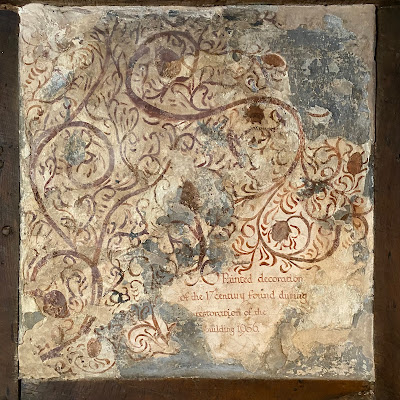Surprise, surprise!
Walking along Friar Street in Worcester, we were drawn to a timber-framed building opposite Greyfriars by a sign advertising second hand books. Greyfriars is an impressive timber-framed medieval merchant’s house on a site close to a medieval Franciscan friary and is now owned by the National Trust. Into the building opposite we went, to discover that the National Trust has installed a shop here, convenient for visitors to its property across the street.
Although on this occasion there seemed to be nothing for me in the stock of books on display, I was pleased I entered the building because of the chance to see two panels of painted wall in an upstairs room – I had no idea they were there. These roughly square patches of scrolling stems have probably faded a good deal, but they still give the lie to a common assumption – that houses a few centuries ago had rather dull interiors with just a few sticks of furniture to enliven the living space. Of course, there would have been huge variation in the quality and quantity of decoration. This is building, now number 14 Friar Street, was once part of a larger house, its other half now comprising the neighbouring number 16. It was the substantial residence of someone with some disposable income – an artisan, or merchant, perhaps.
The paintwork was discovered when the building was restored in 1956, and a proud if somewhat intrusive inscription records this fact. However, knowledge of painted decoration has built up since the 1950s and authorities now think the date is more likely to be 16th century; for another example of 16th-century wall painting (still more elaborate than this), see a post I did about a room in Ledbury, here. Apparently, the Worcester building was home in the early part of that century to one John Watters, ‘paynter’, and may have been built for him in c. 1526. The owner’s trade opens up the interesting possibility that he may have done the decoration himself. Back then it would have been admired but hardly exceptional. He’d probably be surprised to know how much it is cherished now.
Subscribe to:
Post Comments (Atom)





No comments:
Post a Comment